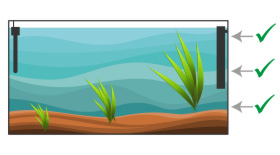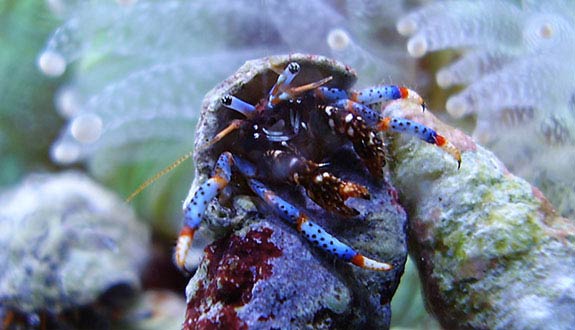

Alternative species (click on the thumbnail to see the card)
Names
Scientific name
Clibanarius tricolor
Clibanarius brachyops
Clibanarius hebes
Pagurus tricolor
Common name
Blue legged hermit crab
Tricolor hermit crab
Origin

Origin: Caribbean
Biotope: None
Dimorphism

None
Group

Diogenidae
Volume

50 L / 11 imp gal / 13 US gal
Parameters

T°: 24 à 27°C or 75 to 81°F
pH: 7.5 to 8.5
Density: 1022 to 1026
Difficulty

Easy
Size

6 to 6 cm (0.4 to 2.4")
Longevity

2 to 3 years
Living zone

Everywhere
Individuals

1
Food
How to feed the hermit crab?
Food
How to feed the hermit crab?
The Blue-legged hermit crab is vegetarian and detritivorous. In your aquarium, it will eat cyanobacteria and filamentous green algae. It thus limits the spread of algae. On some occasions, it will also nibble some residue. Note, however, that it is a little less effective than its cousin Calcinus in its consumption of cyanobacteria.
If it is doing its job too well and the seaweed is scarce, make sure to add dried seaweed for example so that it can eat properly.
Behavior
What kind of behavior does the Palette hermit crab have?
Behavior
What kind of behavior does the hermit crab have?
Peaceful and calm with everyone, it is very active and will look for food day and night.
Cohabitation
Who can live with the hermit crab?
Cohabitation
Who can live with the hermit crab?
It coexists without difficulty with all species of reef aquarium, fish or invertebrates.
Some aquarists have had problems with the association C.tricolor/snails. However, if hermit crabs have empty shells at their disposal to grow when they wish, this behavior should not occur. Also consider the number of hermit crabs in your aquarium because fights for the best shells can occur. By multiplying the number of shells according to your population, you favour infraspecific understanding.
Watch out for cohabitation with Balistes because they are predators for hermit crabs.
Breeding
How to breed the hermit crab?
Breeding
How to breed the hermit crab?
The breeding of the Blue-legged hermit crab has not yet been successful in individuals. In breeding farms, it is carried out in semi-liberty with the assistance of the man. The specimens sold in stores are either from these farms or taken from their natural environment where they are abundantly represented.
Its aquarium
Which aquarium for the hermit crab?
Its aquarium
Which aquarium for the hermit crab?
The Blue-legged hermit crab is not particularly sensitive to its decor. As a result, it will be perfectly at home in all reef aquariums decorated with rocks, algae and invertebrates (corals). It does not damage corals or jostle them, unlike other Hermit crab species.
You can introduce these animals when starting your aquarium, just after the maturation phase and well before the fish.
Its growth is carried out by successive moults of its exoskeleton. It can decide after a moult to go in search of a new shell. To satisfy this instinct, leave empty shells of different sizes at your disposal. Its final size may therefore vary according to the chosen shells.
Good To know
Find all additional information!
Good To know
Find all additional information!
Beware of chemical treatments (especially those based on copper) that it supports very badly. Aside from that, it is very robust and can be offered to beginners.
Yours photos!
Comments
Sort by:
Please login to post comments

